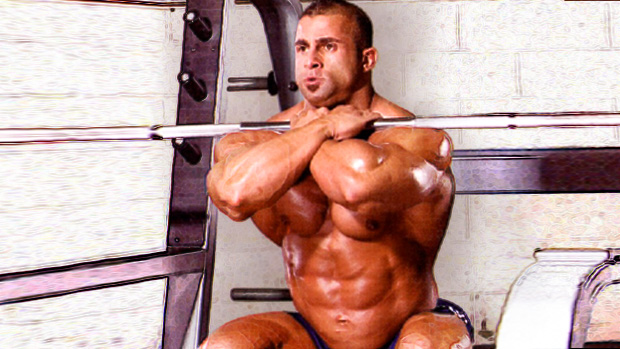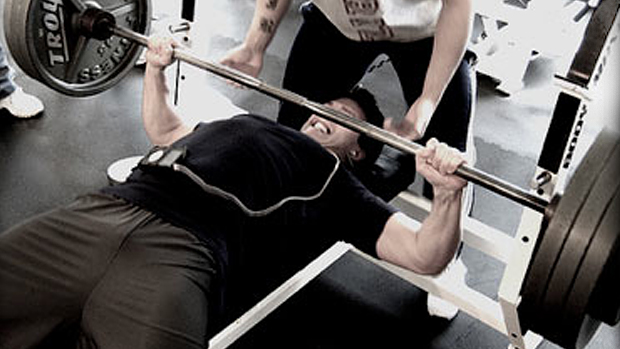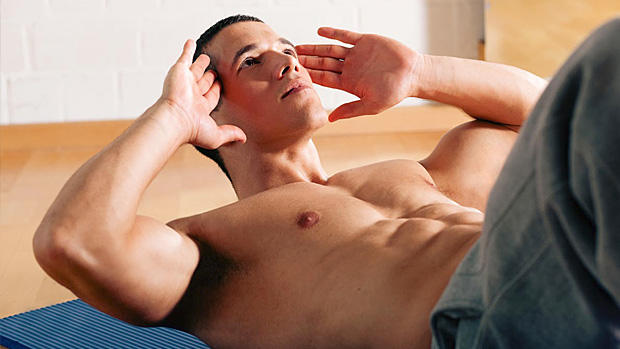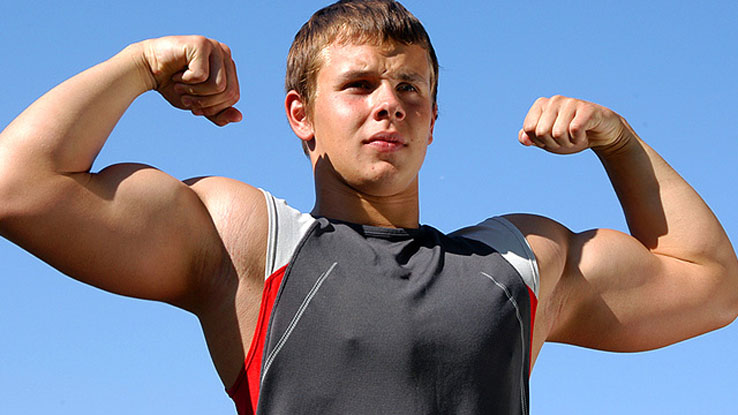People ask me to share training insights on everything from winter sports to the fighting arts. I help as I can, but quite often their questions are variations of, "Dan, I'm doing the One Lift a Day Program. If I add a second lift, will it still be one lift a day?"
The questions that I can never get around to answering well deals with rest. How many seconds do you rest after a max deadlift? In my experience, three weeks. How long do you rest after a set of 20-rep squats with 405 on your back? It seems to be somewhere between ten minutes and the next harvest moon. Of all the topics in training, rest is the hardest for me to help others get a handle on. Me? Oh, I understand it.
I've been there. I hadn't missed a workout in five years. I trained on Christmas day, heavy and hard. I worried over finding a gym on family vacations so I wouldn't miss a single front squat or heavy clean. I swallowed gag-filled soy protein shakes that probably did more hormonal damage than good, and, when mixed with whole milk, turned slight acne into a burn unit case. I did "everything right." No alcohol or marijuana passed these lips, and, sadly, few female lips, too.
And, then, I melted down. Fortunately, it was such an epic meltdown that when my wife first met her current boss, he mentioned being from Montana. My wife laughed and said, "The only thing I know about Montana is that my husband got hit in the head by a discus there." Tiff's boss stiffened, "Oh my God, that was your husband?"
Flashing back, I was standing outside the sector between throws talking to our assistant coach, Ferron Sonderegger (you just can't make up names like that) and his eyes widened. Before he could speak, I'd been hit in the skull by a two-kilo metal and wood discus that had just travelled about 140 feet through the air. It was my fault; I should've paid attention.
The impact should've killed me, but, well, the universe had other plans. The resulting personality change from the concussion did some interesting things. First, I made every bad decision I could for about five or six months, and I apologize for that. Second, I totally lost some memories, as I had the chance to display at my Russian history class that next week. I sat down, looked up at Professor Glatfelter and said, "I don't remember anything."
But, the third was unexpected: I quit. I stopped training. I stopped throwing. I quit school.
Somewhere around October, about five months after the hit to the head, I woke up. My handwriting returned, too. Well, it improved from illegible scrawl to awful, and with that, I began rebuilding my life. I went back to school, started training again, and, to my surprise, was stronger than I'd ever been in my life. I threw the discus and hammer far further than before with less effort.
I'm still working on the insights that I've unpacked from this experience. Part of the reason I'm so vague on rest, especially rest periods between sets, is that I see rest as a continuum that needs to be discussed in detail before moving on.
Eternal Rest
Let's start with the big one: eternal rest. This isn't a theology discussion, but as I always tell my athletes, "You can rest all you want when you're dead."
There are two sides of this first point: longevity and eternal life.
Longevity: Sadly, few gurus in the strength and conditioning field talk about longevity any more. My favorite magazine growing up was Strength and Health. We seem to only talk about health when it goes downhill. "Living well as long as one can for as long as one can live well" is more than just my first attempt at a country and western song. It's a reality for me.
As I walk on closer each day to my death, the quality of life is important. I was told by my doctor years ago that there are only two statistically relevant issues for living longer:
- Don't smoke
- Wear your seatbelt
Everything else is arguable. There are people living over 100 who'll recommend a good cigar, as well as others who'll give frightening advice like "never drink booze."
But, I'm not just interested in the number of my years; I worry about the quality of my time here on Earth. Clearly, the best sign of age is a relative abundance of lean body mass. I want to cling to muscle and keep body fat at bay for as long as I can. Hypertrophy training, as I've noted before, becomes even more important as one ages. In addition, the impact of a 42-year athletic career has led me to believe that joint mobility trumps practically everything else when it comes to dealing with the ills of age. In other words, stay lean, muscular, and loose for as long as you can.
As I continue to watch the sad lines of my friends die way too young, often from the effects of youthful experimentation with drugs (usually the "performance enhancing" kind), I realize that longevity is only important when it's your turn.
Eternal life: I'm not going to get into what happens after you die, but I've always believed the religion-wide idea of "do to others what you'd want done to you" is a big factor in how things are going to end up on the "other side."
I've also embraced a teaching from Steve Ilg in his book, Total Body Transformation. He asks a simple question: "When was the last time you picked up some litter?" The other day, I cleaned up a neighborhood eyesore that's bugged me for weeks and felt lighter and happier. Each time I drive past it, I feel better.
Also, take some advice from one of my favorite characters in literature, the Alewife:
Gilgamesh, whither rovest thou?
The life thou pursuest thou shall not find.
When the gods created mankind,
Death for mankind they set aside,
Life in their own hands retaining.
Thou, Gilgamesh, let full be thy belly.
Make thou merry by day and by night.
Of each day make thou a feast of rejoicing,
Day and night dance thou and play.
Let thy garments be sparkling fresh,
Thy head be washed; bathe thou in water.
Pay heed to the little one that holds on to thy hand,
Let thy spouse rejoice in thy bosom!
For this is the task of mankind!
The Role of Rest
The Alewife leads us to the next point, where's the role of rest in your life? For years, I've been giving a workshop that discusses a point that I was taught in the second grade. Now, if something I learned in the early 1960s still impacts my thinking and teaching today, it's worthy of discussion.
My teacher went to the board and put up four words where North, South, East, and West would be on a compass. They were "play," "pray," "rest," and "work." She made a simple point: In life, these four things must be balanced. If one gets too far, like work, you'll slowly burn out. If you play all the time, like the grasshopper in the story The Grasshopper and the Ant, you'll have to catch up when things go wrong (and they always go wrong). Praying could simply be alone time or your efforts to do those internal exercises that keep us going along.
Rest is the problem for many of us today, as we tend to stay up longer and longer, cutting into our sleep time. Also, working 60 hours a week leaves little time to take care of rest!
I listen closely to people who build an understanding of this concept into their programs. Ilg's Total Body Transformation is a handbook of bringing strength training, yoga, meditation, nutrition, and life together into one system. I've always enjoyed reading Pavel's two-headed monster of brutal, grinding strength training with insightful, even artistic, flexibility and mobility work.
My simple compass of rest, play, pray, and work illuminates my life. Certainly, I've ignored it throughout my years (just read my articles for just some examples of my idiocy), but when I'm at my best, I attempt to tie together these four points in all my life.
A few examples:
Wine walks: Long walks are an underappreciated element in strength training. I'm not talking about packing on plates and sleds and attacking a mountain; I'm thinking of what my wife and I do on occasion. I have this specialty backpack that holds a bottle of wine, glasses, and an opener. We go for a long, easy walk and find a suitable place to pop the cork, talk about life, laugh, and enjoy nature and our relationship. (The walk back is always interesting.)
Meat fests: We have a tradition of bringing a bunch of people over to our house to train. Because of the numbers, we have to move to the way back where we set up the Highland game equipment, weights, sleds, kettlebells, and odd stuff. The group dynamic tends to lead to long, fun workouts with some challenges and a lot of laughs. We all bring cuts of meat and end with a long party of meat and drinks.
Throw training: One of the ways I prepare myself for competition is to bring a kettlebell out to a field with my discus (or whatever implement is going to be part of the next competition). I combine throwing with various kettlebell drills for as long as I need to be there. I try to just keep finding the small spaces in my body to stretch out with the kettlebell and try to carry this feeling over into my throwing. I try to go "inside" during this time and block out everything and everyone else. Oddly, most of my articles seem to pop into my head during these workouts, especially the ones where I think I need to talk about rest.
One could argue that mixing these three workouts would be an ideal way to train. It certainly has the feel for covering all the keys to training. Notice how the four elements of play, pray, work, and rest naturally come together in these workouts. Take a few minutes to assess your life and see if any of these elements are missing from your life. If you work, work, work, keep your eyes open for a discus.
Layoffs and Vacations
The next stop on my continuum of rest is to understand layoffs and vacations. I seem to constantly give conflicting information. For example, if you want to lose fat, stop talking and give me 28 days of the Velocity Diet. If you want flexibility, sign up for the Bikram yoga 30 challenge and give it a go.
I also give this advice: Take six weeks off.
What? It's something I've never done on purpose. Oh sure, after this surgery or that surgery, I took time off, and when I got really sick, I took two weeks off. In hindsight, I should've listened to a friend who had studied sports training in another country. I asked him about how Americans trained. His response, "Well, the consensus is that you're all overtrained."
"What about me?"
"Dan, you're the poster child for overtraining."
Off the top of my head, I'd suggest that a hard training individual take about six weeks off a year. And, I mean off. No basketball tournaments, no aerobics classes, nothing.
Now, the sad thing is this, basically, those of you who don't train hard just decided to take the next six weeks off. Those who train hard will take those six weeks off when they're dead. I never understood taking time off until far too late in my career. I remember Dan Cantore, fresh from the 1976 Olympics, telling me he was taking some time to "regroup." My thought was, "The next Olympics are just four years away!" I could've had "more career" by more "regrouping."
In the same vein, when you go on vacation, go on vacation. Don't try to keep your normal training going. Now, having said this, I also find that visiting a weightroom or gym on a trip allows me to meet a bunch of new people and enjoy experiences that might not happen otherwise. You need to make a choice on this as to whether or not you want to have a fun minimal workout on vacations, but I also enjoy the free food and drinks that always seem to follow my little coaching pointers in an alien gym.
There's also a lot to be said for "active rest." It's a term that's been around for decades, but is still overlooked. It's this idea: For a few weeks, instead of doing your basic training, get involved in some other activity. Famously, the Soviet athletes got into volleyball, so much so that several weightlifters achieved Masters of Sport in the game. The German discus throwers used to enjoy downhill skiing, and it's hard to imagine American athletes who don't enjoy pickup basketball games. Enjoy active rest long enough to realize that your gifts are probably not good enough for the NBA.
The Wonders of Sleep
Sleep, the daily cure for all that ails you, is still overlooked as the key to recovery. Years ago, after reading Lights Out: Sleep, Sugar, and Survival, by T. S. Wiley, I came away with the courage to do a famous experiment on myself. I'd try to sleep up to 12 hours a day for a week. The body fat dripped off of me that week, and I had to force myself to eat.
To prepare myself for this article, I decided to follow that path again. As I am typing this, I'm coming off a 12-hour snooze. Yesterday, I only got nine hours of sleep, but I was able to sneak in a three-hour nap in the afternoon. My young friend, Chloe Clark, calls the afternoon sleep "the short nap" and the evening sleep "the long nap." Napping is underrated and worthy of an article on its own.
The first time I tried this experiment, I went from 226 to 214 in about six days. I ate zero carbs, save one salad, and really feasted on eggs and coffee. I'm still bravely working on this protocol, but I did sneak on the scale yesterday and saw I was 222. That's less than I weighed when I finished the Velocity Diet. On the V-Diet, I ate nothing, but enjoyed six shakes a day. On this diet, I lay around in bed. You decide which one is easier.
Not long ago, I was called out on another forum for "pimping" supplements. Bah, I say to you. I do things that work. If they work, I tell you about them. One may note that I don't tell you everything I try because not everything you pop in your mouth works like promised. (Where's my bee pollen?)
There are some supplements that I use every night to help with sleep. Years ago, I had two friends divorce their wives and make very poor decisions over the course of about two years. One buddy ended up in Federal prison as a result of these decisions. Talking with both of them, they had one common sentence, "I can't sleep through the night. I only get about four hours." After a few months of no sleep, they both started making bizarre choices. I learned from that lesson: Lack of sleep is not only hard on your training; it's hard on your life.
First, invest in a good bed, good pillows, and adequate blinds. We buy new pillows at least once a year, usually twice. We take the old pillows on trips or use them in the television room. You spend a third of your life in bed, so invest wisely.
Second, about a half an hour before I go to bed, I take the following:
3 ZMA®
3-5 Flameout®
A serving of orange sugar-free Metamucil
With a glass of wine, you can feel the body relax. I think magnesium continues to be the most underrated of supplements, and its wonderful calming effects combined with its wonders for the bowels keeps it as my first place winner as supplement of the year.
If you have a hard time sleeping, read before bed, but don't watch television or play on the internet. If you need books that'll put you to sleep, try the Twilight series. (Oh, meow!)
For napping, you can only do what you can do. I have a small cot at work, and I found a place that no one will bother me for about twenty minutes, and I'm not telling you where that is! Some suggest eye shades and those airline neck pillows, and I think that might be a good idea. If you can nap, do it. The tradition in elite track and Olympic lifting athletes is a daily nap. I asked a Russian friend what was the technical term for this afternoon nap and he gave me an odd Russian term: siesta.
The Least Important Rest
So, now let's look at what I consider the least important concept in rest: the rest period between sets.
I'm always amazed when I read massive 12-week training programs and the author has given us varied rest periods for every lift and movement for every workout of every day of the program. My experience is that rarely do people follow a workout plan for two days, much less 84. But there those numbers sit patiently. In the past, rest periods were given in minutes, but today there's a move to seconds. When I'm training hard, my awful math skills degenerate so much that I have no idea how long 240 seconds is going to be, so I just wait about four minutes and go.
Here's the issue, and most strong and accomplished people would agree: For an accomplished trainer, rest periods are more fluid. When Vasili Alexeev clean and jerked 500 pounds for the first time in Columbus, Ohio in 1970, how long did he rest before he added weight to do another? It's a crazy statement to even make. A novice trainer doing a set of ten benches on a machine can repeat that performance very quickly.
The genius of measuring rest periods is that you can honestly compare one workout to another. I've found that sets, reps, and load only tell part of the story in a standard workout. In my favorite workout scheme – three sets of eight with one minute of rest between sets – I can gauge how I'm doing from literally year to year, and, in the case of overhead squats and front squats, from decade to decade. Without the truth of the rest period, you're comparing apples to oranges, or whatever cliché fits the day.
In some workouts, the rest to work ratio is the workout. Kenneth Jay's "Viking Warrior" training of mixing 15 seconds of kettlebell snatches with 15 seconds of active rest for up to forty minutes is an attempt to drive your VO2 max through the roof. The oft misunderstood Tabata protocol is supposed to feel awful and difficult from the first set. It is not twenty seconds of hand waving, ten seconds of rest, and twenty seconds of something else. In my article, Fat Loss in Four Minutes, most people still think the workout is a fun change of pace. The actual twenty seconds on and ten seconds off with front squats is a way to ruin several days in a row.
Putting It to Rest
So, when I get asked about rest, I get lost in this continuum. From literally death to the details of a small part of a workout, rest means a lot to me. It shouldn't be considered something to do when you're done, but one should actively think about resting.
To summarize:
- I'm not against giving advice about rest periods between sets; it's just that I think there are many other keys to discuss before I tell you that you need 118 seconds between sets of reverse sumo curls in the Smith machine.
- Since most of the information concerning rest is free (no one charges you for sleep), there's no market, and therefore, you don't hear much about it.
- Truly, any balance you bring to your training is going to help. Taking the time and effort to intelligently add rest is going to pay off better than buying a new curl machine.
Don't take a discus to the head to learn the importance of taking a look at rest and recovery.





